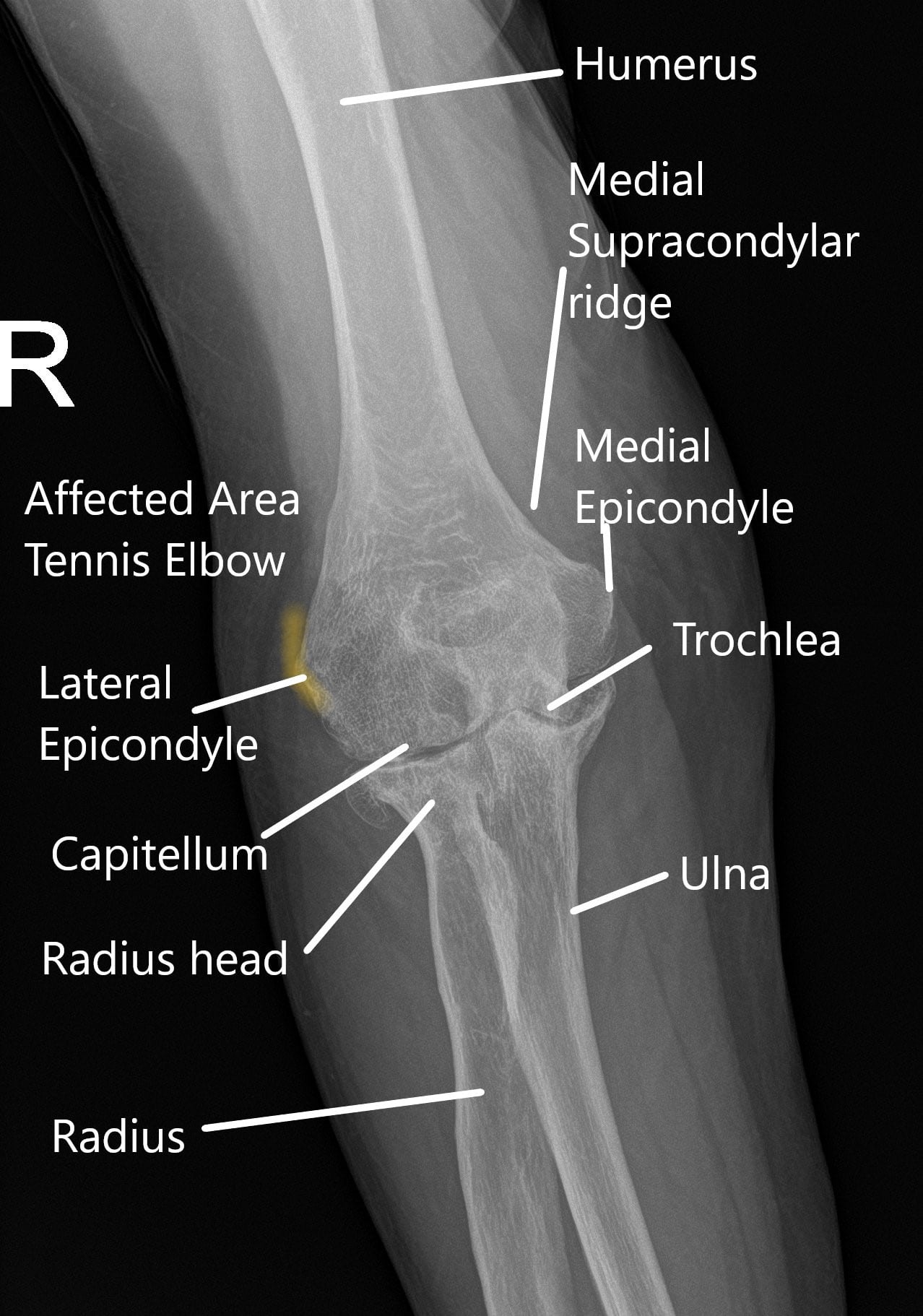Tennis elbow is known as lateral epicondylitis. Tennis elbow occurs most commonly between the ages of 30 and 50 years. Despite the name, the painful condition is more common among non-athletes rather than athletes. The pain is due to inflammation and tears of the tendons attached to the outer side of the elbow.
Anatomy
The elbow joint forms between the lower end of the arm bone and the upper end of the two forearm bones. The arm bone is known as the humerus and the two forearm bones as radius and ulna. Various muscles, tendons, and ligaments stabilize the joint. There are small bony bumps on the inner and outer side of the elbow known as epicondyles.
The bump on the outer side is known as the lateral epicondyle. The muscles of the forearm used to straighten the wrist and fingers are attached to the lateral epicondyle. The muscles attach to the bone through tendons.

X-ray of the elbow in the AP view.
Cause
Overuse injury due to repetitive contractive of muscles used to straighten/extend the wrist and fingers result in tennis elbow. Repetitive movements may cause small tears in the tendons attached to the lateral condyle. The small tears may lead to the formation of scar tissue or the complete rupture of the tendon.
Extensor carpi radialis brevis is the most commonly involved tendon in the disease process. The tendon plays an important role in stabilizing the wrist joint with an extended forearm. Activities involving rotational movements of the elbow with a straight arm are especially culpable.
- Backhand stroke while playing tennis with improper technique.
- Other sports such as racquetball, squash, fencing, etc.
- Painters, plumbers, carpenters, meat butchers, etc.
- Typing, driving a screw, using a computer mouse, knitting, etc.
Symptoms
The symptoms of tennis elbow are the pain located on the outer side of the elbow and mild swelling. The pain often may go down the forearm and wrist. The symptoms may also include a weakened grip. The patients often find it difficult to hold a cup, turn a doorknob, shake hands, and play racquet sports.
Diagnosis
A sports medicine physician will examine the patient after a thorough history of the pain. An examination may involve applying pressure over the outer side of the elbow. The physician may do various maneuvers such as apply resistance to straightened middle finger and wrist.
For further evaluation, an X-ray may be ordered to look for bone spurs or arthritis. Other studies such as an MRI may be requested.
Nonsurgical Management
Tennis elbow usually gets better with conservative methods and limiting activities that involve repetitive forearm muscle contraction.
- Rest to the elbow is important to give time for healing of the diseased parts. The patient has to stop any activities which may be further detrimental to the condition.
- Nonsteroidal anti-inflammatory drugs are usually helpful to reduce inflammation and swelling.
- A tennis elbow brace usually tied 1 fingerbreadth below the tender point helps to decrease tension developed by the tendon.
- Physical therapy aimed to stretch and strengthen the muscles around the elbow is helpful.
- Eccentric exercises are done under physical therapists which involve slowly bending the wrist.
- Steroid injections may be given at the outer side of the elbow for relieving inflammation.
- Plasma Rich Platelet (PRP) injections involve injecting the patient’s own blood rich in growth factors. It is a new treatment being explored for the treatment of tennis elbow.
- Ultrasound Therapy involves the delivery of high-frequency ultrasonic waves through a needle to dissolve the diseased tissue. The liquified diseased tissue is subsequently taken out of the elbow with the syringe.
- Needling involves making multiple holes in tendon with the ultimate goal to hasten the healing process.
Surgical Management
The surgical management for tennis elbow is reserved for patients not benefitting from conservative management. Usually, a trial of conservative management is given for at least 4-6 months. Surgical management is also used in patients with significant restrictions on daily activities due to pain and weakness.
The choice of surgery usually depends on the patient’s condition and requirements. The surgery can be an open procedure or arthroscopic procedure. Both procedures are usually daycare procedures and rarely require any hospital stay.
Open Surgical Procedure
The goal of the surgical procedure is to debride or remove the diseased tendon/muscle. The healthy tendon/muscle is then reattached to the bone. A small incision is made on the outer side of the elbow. The diseased extensor carpi radialis brevis is resected and directly attached to the bone.
Arthroscopic Procedure
The arthroscopic procedure utilizes a minute camera and minuscule tools. The camera relays the live feed to a digital screen. The surgeon utilizes the digital output to guide the minuscule tools. As with the open surgery, the diseased tissues are removed and the tendon repaired back to the bone.
The arthroscopic procedure provides an additional advantage of minute incisions. The surgery is a daycare and the patient can walk home the same day. After the surgery, the patient follows a rehabilitation process for strengthening the muscles around the elbow.
Do you have more questions?
Can tennis elbow occur in individuals who do not play tennis?
Yes, tennis elbow can occur in individuals who engage in activities involving repetitive arm motions, such as typing, painting, or using hand tools.
What are the symptoms of tennis elbow?
Symptoms of tennis elbow typically include pain and tenderness on the outside of the elbow, worsened by gripping or lifting objects, and may radiate down the forearm.
How long does it take for tennis elbow to heal?
The healing time for tennis elbow varies depending on the severity of the condition, adherence to treatment, and individual factors, but it can take several weeks to months to resolve completely.
Can tennis elbow heal on its own without treatment?
In some cases, mild cases of tennis elbow may improve with rest and conservative measures, but persistent symptoms may require medical intervention for relief.
What are the treatment options for tennis elbow?
Treatment options for tennis elbow may include rest, ice therapy, anti-inflammatory medications, physical therapy, bracing or splinting, corticosteroid injections, and in severe cases, surgery.
How effective are corticosteroid injections in treating tennis elbow?
Corticosteroid injections can provide temporary relief from pain and inflammation in tennis elbow, but their long-term efficacy may vary, and repeated injections carry risks of tissue damage or weakening.
What are the risks associated with surgery for tennis elbow?
Risks associated with surgery for tennis elbow may include infection, nerve or blood vessel injury, stiffness, weakness, and failure to relieve symptoms or improve function.
Are there any exercises or stretches recommended for tennis elbow?
: Yes, specific exercises and stretches targeting the forearm muscles and tendons can help alleviate symptoms, improve strength and flexibility, and prevent recurrence of tennis elbow.
How can individuals prevent tennis elbow from recurring?
Preventive measures for tennis elbow recurrence may include proper technique during activities, gradual progression of intensity or duration, using ergonomic equipment, and maintaining forearm strength and flexibility through exercises.
Can tennis elbow lead to complications if left untreated?
Yes, tennis elbow left untreated can lead to chronic pain, decreased grip strength, difficulty performing daily activities, and potential progression to more severe conditions such as tendon degeneration.
Can certain occupations or activities increase the risk of developing tennis elbow?
Yes, occupations or activities that involve repetitive arm motions, forceful gripping, or wrist extension can increase the risk of developing tennis elbow, such as painting, carpentry, or using hand tools.
How does age and lifestyle factors influence the development of tennis elbow?
Age-related changes in tendon elasticity and strength, as well as lifestyle factors such as occupation, sports participation, and overall physical activity level, can influence the development and severity of tennis elbow.
Can tennis elbow affect sports performance or work productivity?
Yes, tennis elbow can affect sports performance by limiting grip strength, accuracy, and endurance, and can impact work productivity by causing pain and functional limitations during daily tasks.
Are there any alternative treatments or therapies for tennis elbow?
Alternative treatments or therapies for tennis elbow may include acupuncture, chiropractic care, massage therapy, shockwave therapy, and use of orthotic devices, but their efficacy may vary, and scientific evidence supporting their use is limited.
Can certain medications worsen symptoms of tennis elbow?
Yes, certain medications such as fluoroquinolone antibiotics or statins have been associated with an increased risk of tendon injury or rupture, which may exacerbate symptoms of tennis elbow.
How can individuals determine if their symptoms are due to tennis elbow or another condition?
A medical evaluation by a healthcare professional, typically an orthopedic surgeon or sports medicine specialist, can help determine the underlying cause of symptoms and guide appropriate treatment.
Can tennis elbow be managed with non-surgical interventions alone, or is surgery often necessary?
Many cases of tennis elbow can be effectively managed with non-surgical interventions such as rest, physical therapy, and medications, but surgery may be considered for cases that do not respond to conservative treatment or for severe symptoms.
What are the benefits and drawbacks of surgery for tennis elbow compared to non-surgical treatments?
The benefits of surgery for tennis elbow include potential long-term relief of symptoms and improved function, but drawbacks include risks of complications, longer recovery time, and potential for recurrence. Non-surgical treatments offer less invasive options with generally shorter recovery times but may not provide long-term relief for all individuals.

Dr. Suhirad Khokhar
My name is Dr. Suhirad Khokhar, and am an orthopaedic surgeon. I completed my MBBS (Bachelor of Medicine & Bachelor of Surgery) at Govt. Medical College, Patiala, India.
I specialize in musculoskeletal disorders and their management, and have personally approved of and written this content.
My profile page has all of my educational information, work experience, and all the pages on this site that I've contributed to.
